|
|
Post by groundhog on Jul 3, 2013 22:28:30 GMT
James Quinlan
Savage’s Station, Virginia
29th June 1862  The Battle of Savage’s Station was fought as part of the Peninsula Campaign. The Union Army had quickly lost the initiative and was in full retreat across the James River. The rearguard of the army was II Corps. Tipperary-born James Quinlan was a Major and commanding officer of the 88th New York Infantry on 29th June 1862. Quinlan led his regiment on a Confederate battery, silenced the guns, held the position against overwhelming numbers, and covered the retreat of the II Army Corps. He was awarded the Medal of Honor for this day’s work, but not until 18th February 1891. Quinlan was born in Clonmel on 13th September 1833 and died in New York on 29th August 1906. He is buried in Calvary Cemetery, Queens. |
|
|
|
Post by groundhog on Jul 4, 2013 8:37:18 GMT
Thomas Burke
Hanover, Pennsylvania
30th June 1863  Thomas Burke was born in Ireland in 1842, serving during the Civil War in Company A, 5th New York Cavalry. He earned the Medal of Honor on 30th June 1863 when he and a Cpl Rickey charged two Confederate soldiers holding a flag. Rickey’s horse was shot but Burke continued his charge, capturing both men and the flag. There seems to be some confusion as to where this happened though. Official US Army sources say at Hanover Courthouse, Virginia, other sources say the village of Hanover, Pennsylvania. Since the 5th New York Cavalry participated in the Battle of Gettysburg two days later and just 15 miles away, I’m going with Hanover, Pennsylvania. Burke died in New York on 15 th March 1902 and is buried in Woodside, Queens. |
|
|
|
Post by groundhog on Jul 4, 2013 11:38:29 GMT
Malvern Hill, Virginia
1st July 1862  The Battle of Malvern Hill (or Poindexter’s Farm) was the sixth and last of the Seven Days’ Battles and part of the Peninsula Campaign. On 1st July 1862, Gen. Robert E. Lee launched a series of disjointed assaults on the Union position on Malvern Hill. The Confederates suffered more than 5,300 casualties without gaining any ground. Despite this victory McClellan, convinced he was seriously outnumbered withdrew to entrench at Harrison’s Landing on James River, where he could take advantage of naval gunfire support. Malvern Hill also ended the Peninsula Campaign and, with the threat to Richmond ended, Lee sent Jackson to operate against Pope’s army along the Rapidan River, initiating the Northern Virginia Campaign. Two Irishmen earned Medals of Honor at Malvern Hill. John Tobin  John Tobin was born in Co. Waterford in 1841. He joined the army in Boston and served as First Lieutenant and Adjutant of 9th Massachusetts Infantry at Malvern Hill. From about 3 in the afternoon until dusk, command of the regiment fell to him. During the battle he rallied and reformed the regiment. In common with many men his Medal of Honor wasn’t awarded for many years, being issued on 11th March 1896. Tobin died on 27th December 1898 and is buried in Mount Auburn Cemetery, Cambridge, Massachusetts. Peter Rafferty  Peter Rafferty was born in Tyrone on 12th June 1845, making him 17 years old when he won his Medal of Honor at Malvern Hill. Rafferty was serving as a Private in Company B, 69th New York Infantry. During the battle he was wounded and ordered to the rear but opted instead to stay with his unit. He was wounded several more times, shot twice in the face and once in the foot, and captured by the Confederates. At some stage he must have been exchanged as his wounds rendered him unfit for military service. However he had recovered sufficiently to volunteer again in 1864 when he was commissioned a Captain. His MOH was awarded 2nd August 1897. He died on 30th April 1910 in New York and is buried in Calvary Cemetery, Queens. longislandwins.com/index.php/features/detail/union_defeat_and_an_irish_medal_of_honor_at_the_end_of_the_seven_days/ |
|
|
|
Post by groundhog on Jul 4, 2013 11:53:56 GMT
William Ahern
USS Puritan, Brooklyn Navy Yard
1st July 1897 Ahern (sometimes mistakenly referred to as O’Hern) was born in Ireland in 1861. In 1897 he was a Watertender in the US Navy serving aboard USS Puritan. A collapse of the crown sheets of Boiler E threatened the rest of the boilers. Ahern wrapped himself in wet cloths to protect his face and arms, entered the fireroom and crawled over the tops of the boilers to close the auxiliary stop valve, disconnecting boiler E . He was awarded the Medal of Honor for his courage on 1st November 1897. His date and place of death are unknown. New York Times, 6 February 1898
HEROES REWARDED
While many heroic deeds have been performed by the officers and men of the United States Navy during the past thirty years, it was not until recently that any recognition by the Government has been shown to some of these brave men. The first two men to be awarded medals of honor for gallant conduct since the war are August Wilson, a boiler maker, and William O'Hearn, a water tender. Both men were attached to the United States monitor Puritan, and it was while on duty on that vessel that they displayed such bravery, and by their cool and quiet action not only saved the lives of the officers and men attached to the ship, but saved the vessel from untold damage.
The deed through which the men won the medal of honor was performed on July 1, 1897, while the Puritan was at the Brooklyn Navy Yard. The repairs to the vessel had been completed, and the engines were having a "dock trial" prior to the ship's departure, when the crown sheets of boiler E collapsed, sending volumes of steam and boiling water into the fireroom, where Chief Engineer George W. Cowie, Jr., and the men of his division were at work. So dense was the steam that the men had to grope their way from the room. Engineer Cowie was badly scalded about the face and hands while trying to reach the safety valve, which he wished to open. All the boilers were connected with the damaged one, and were in immediate danger of exploding. No time was to be lost, as the collapsing of the crown sheets of the other boilers meant not alone injury to the vessel, but probable loss of life.
August Wilson assisted Engineer Cowie from the fireroom. Several men were dragged out of the place by both Wilson and O'Hearn. Mr. Cowie tried to return to the fireroom, but was prevented by Wilson, who said: "Don't go in there, Mr.Cowie, you are badly burned now. I will go," and both he and O'Hearn, after wrapping wet clothes about their faces and arms, entered the fireroom. Several men were still in the place, having become dazed by the steam which was pouring forth. They were taken to places of safety. Wilson opened the safety valve, while O'Hearn crawled over the tops of the boilers and closed the auxiliary stop valves, disconnecting the damaged boiler, and removing any danger of explosion from the other boilers. John P. Yates, chief machinist,
and William J. Lee entered the fireroom and worked personally hauling the fires, thus reducing the danger to a minimum.
Capt. P. F. Harrington, commanding the Puritan, in his report of the accident and the conduct of the men to Admiral Sicard, said: "The circumstances of the conduct of August Wilson and William O'Hearn were of extraordinary heroism and gallantry, and I respectfully recommend that medals of honor given them." Admiral Sicard complimented the men who helped save the ship from danger, and in his report to Secretary Long spoke of the excellent example that the men set, and recommended them for medals of honor for the "dangerous part of the duty they undertook." The medals were presented about a month ago. Both Wilson and O'Hearn have been in the service many years, and both have received medals for their good conduct.
|
|
|
|
Post by groundhog on Jul 4, 2013 20:09:40 GMT
Santiago, Cuba
1st July 1898 A few days ago we saw the US Navy in action in Santiago Harbour, Cuba. On land the US Army launched an attack on the town on July 1st 1898. As part of this assault the army had to attack a ridge three miles east of the town. Two Irishmen serving in the 21st Infantry Regiment won Medals of Honour in what would become known as the Battle of San Juan Hill. [/img] 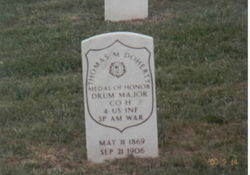 [/center] Doherty was born in Mitchelstown Co. Cork on 11th May 1869. During the Spanish American War he was a Corporal in Company H, 21st Infantry. His medal citation issued on 22nd June 1899 red that he “Gallantly assisted in the rescue of the wounded from in front of the lines and while under heavy fire from the enemy.” He died on 21st September 1906 and is buried in Evergreen Cemetery, Southgate, Kentucky. Thomas Kelly 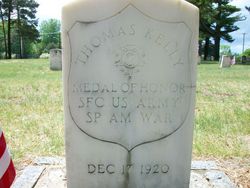 Also in Company H was Private Thomas Kelly. Hi medal, also issued on 22nd June 1899 was for assisting the wounded. Kelly died on 17th December 1920 and is buried in Plattsburg Barracks Post Cemetery, New York
|
|
|
|
Post by groundhog on Jul 4, 2013 20:39:51 GMT
[/img] The 82nd New York Memorial at Gettysburg[/center] Hugh Carey was born in Ireland in 1840. During the Civil War he served as a Sergeant in Company E, 82nd New York Infantry. He won a Medal of Honor for gallantry at the Battle of Gettysburg on 2nd July 1863 when he captured the colours of the 7th Virginia Infantry, receiving two wounds while doing so. Carey’s MOH was a posthumous award, being issued on 6th February 1888, while he had died on 26th March 1886. He is buried in Holy Cross Cemetery, Brooklyn. Although the official US Army record records the date of Carey’s Medal of Honor action as 2nd July, the regiment’s history records that; On the evening of July 2nd, moved to the Emmittsburg Road to protect flank of the Third Corps. Fought there until out-flanked. Returning to this line the Regiment reformed under a galling fire; then advanced, driving the enemy before them; regained their former position, capturing the colors of the 48th Georgia. Among the killed was Colonel Huston commanding the regiment.On the following afternoon; At the time of the enemy's assault on the afternoon of the 3rd, the Regiment moved to the right toward the Copse of Trees and assisted in repulsing the enemy, capturing the flags of the First and Seventh Virginia Regiments.So it seems that Hugh Carey actually won his Medal of Honor on July 3rd 1863, fighting off Pickett’s Charge. |
|
|
|
Post by groundhog on Jul 4, 2013 22:25:22 GMT
Gettysburg, Pennsylvania
3rd July 1863 [/img] The 14th Connecticut Monument at Gettysburg and the stone wall they sheltered behind[/center] Christopher Flynn was born in Ireland in 1828 immigrated to the US and settled in Sprague, Connecticut. He enlisted in August 1862 in Company K, 14th Connecticut Infantry and was promoted to Corporal in November 1862. At Gettysburg the 14th Connecticut fought off Pickett’s Charge from behind a stone wall. During close quarter combat with the 52nd North Carolina, Flynn jumped over wall and struck down the color bearer of the 52nd and captured the regimental flag. It was for this action that he was awarded the Medal of Honor on 1st December 1864. Flynn was wounded at Laurel Hill, Virginia on 10th May 1864, Promoted to the rank of sergeant on 1st March 1865 and discharged from the army on 31st May 1865. He died on 15th October 1889 and is buried in St. Mary’s Cemetery, Baltic, Connecticut. Bernard McCarren  On the right flank of the 14th Connecticut and sheltering behind the same stone wall on 3rd July 1863 was the 1st Delaware Infantry Regiment. In Company C was Private Bernard McCarren, born in 1831 in Ireland. He married Mary Ann Traynor in 1855 settled in Wilmington, Delaware and had two children who both died young. When the Civil War broke out McCarren enlisted in Co. H, 24th Pennslyvania Regiment. He was 5' 9" tall, light complexioned, had blue eyes and sandy hair. His enlistment was for three months and when that ended he joined Co. C, 1st Delaware Infantry. In September, 1861, he was promoted to corporal and later fought at the Battle of Chantilly and at Antietam. Col. Thomas Smyth commanding the Delaware Regiment ordered them to hold their fire until the Rebels were only 50 yards from the wall. When they did open fire, the Rebels kept coming and falling. Finally, the charge faltered 40 feet in front of the Delaware men. Smyth led a counter charge in which he was shot dead. During the charge Bernard McCarren captured the colours of the 7th North Carolina Infantry. McCarren was wounded at the Battle of Wilderness in May 1864. He received his medal on 1st December 1864 and was mustered out of service on 22nd July 1865. He died from Dysentery on 20th June 1870 and was interred in Wilmington's Old Cathedral Cemetery, since relocated to All Saints Cemetery. John Robinson 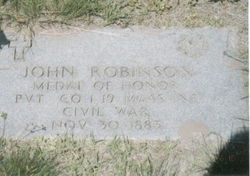 About 300 metres south of the 14th Connecticut's position on Cemetery Ridge was the 19th Massachusetts Infantry. The Massachusetts was in reserve behind the main Union line. Fate placed them at the place where Gen Armistead’s Brigade broke through the Union line and for a while it seemed that Lee’s gamble might win the battle for the Confederacy. The 19th plugged the gap in the Union line and slugged it out with the Rebels, losing over half its strength killed and wounded. During a charge to drive back the Confederates, Private John Robinson of Company I captured the flag of the 57th Virginia Infantry. John was born in Ireland in 1846 and immigrated to the US settling in Roxbury, Massachusetts. His MOH was issued on 1st December 1864. At some later stage in the Civil War he was captured and held as a POW. He died in Roxbury on 30th November 1883 and is buried in Mount Benedict Cemetery, West Roxbury. |
|
|
|
Post by groundhog on Jul 5, 2013 11:01:57 GMT
George Platt
Fairfield, Pennsylvania
3rd July 1863  Fairfield, Pennsylvania was the scene of a cavalry battle on 3rd July 1863. Although fought at the same time and close to Gettysburg, Fairfield isn’t regarded as part of the Gettysburg battle. George Platt was a Private in Troop H, 6th US Cavalry at Fairfield, Pa on 3rd July 1863. The 6th had been sent on a raid to destroy some Confederate supply wagons thought to be in the area. The unfortunate 6th ran into a brigade of Confederate cavalry supported by artillery and was decimated, losing almost 240 men killed and missing. Platt, who was born in Derry on 17th February 1842, took up the regimentl colours when the bearer was killed and saved it from being captured. He was awarded the Medal of Honour on 12th July 1895. George died on 20th Jne 1912 and is buried in Holy Cross Cemetery, Yeadon, Pennsylvania. The George C. Platt bridge in Philadelphia was named in his honour in 1979. |
|
|
|
Post by groundhog on Jul 5, 2013 13:29:59 GMT
John Mitchell
Hell’s Canyon, Arizona
3rd July 1869 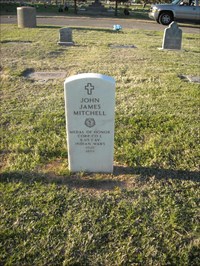 John Mitchell was born in Tyrone in 1846. He served in Company L, 8th US Cavalry in Arizona during the Indian Wars. He was awarded the Medal of Honor for gallantry in action on 3rd July 1869 at Hell’s Canyon, Arizona, the medal being issued on 3rd March 1870. Mitchell died on 15th March 1898 and is buried in Holy Hope Cemetery, Tuscon. |
|
|
|
Post by groundhog on Jul 26, 2013 13:03:55 GMT
James Morris
Fort Selden, New Mexico
8th July 1873 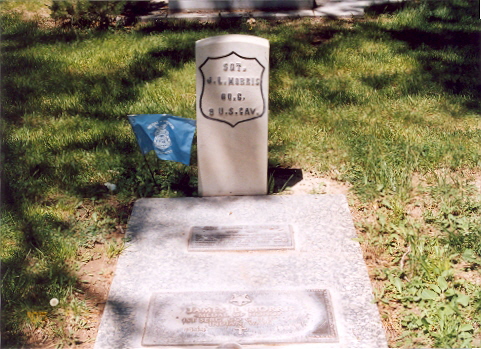 James Morris was born in Ireland in 1844 or 1845. In 1873 he was First Sergeant, Company C, 8th US Cavalry. Near Fort Selden, New Mexico he led a patrol in pursuit of Apache Indians between 8th and 11th July 1873 and was awarded the Medal of Honor on 12th August 1875. Morris died in 1903 and was originally buried in an unmarked grave in Fairview Cemetery, Albuquerque, New Mexico. However he was reburied in 1989 thanks to the efforts of The National Congressional Medal of Honor Society and the New Mexico Hometown Heroes Association, who erected a headstone over his grave.
|
|
|
|
Post by groundhog on Jul 26, 2013 13:33:10 GMT
John Kelley
Hamilton, North Carolina
9th July 1862 John Kelley was a Second Class Fireman in the US Navy. Born in Ireland he was serving aboard the USS Ceres near Hamilton, North Carolina on 9th July 1862. USS Ceres was a side-wheel merchant steamer taken into service as a gunboat by the navy. On the day Kelley won his MOH, the ship was engaged in covering an army landing party. Kelley’s citation reads that “When his ship was fired on by the enemy with small arms, Kelley returned the raking fire, courageously carrying out his duties through the engagement and was spoken of for "good conduct and cool bravery under enemy fires," by the commanding officer.” Although his award was dated 3rd April 1863, Kelley never actually received his medal which is still held by the Naval History and Heritage Command. |
|
|
|
Post by groundhog on Jul 27, 2013 11:06:26 GMT
Big Horn, Montana
9th July 1876 We’re in the middle of the Great Sioux War in Montana. Gen Custer and his men were massacred two weeks previously. The column to which he belonged, that of Generals Terry and Gibbon, is operating along the Bighorn River. With it is the US 7th Infantry Regiment. On July 9th 1876, Gen Terry sent a dispatch to Gen Crook in the hope of co-ordinating operations against the Sioux. Three volunteers carried dispatches to Crook, taking three days to do so. Of the three men who all received the Medal of Honor for their actions, two were Irish. James Bell  Private James Bell, Company E, 7th Infantry Regiment was born in Antrim on 1st July 1845. He immigrated to the US in 1866, joining the army in July 1870. The 7th Infantry were part of Gibbons column operating along the Rosebud River and arriving at Little Bighorn two days after the Custer massacre. Bell was awarded his medal on 2nd December 1876. He spent his life in the army, married in 1888 and died on 1st July 1901 in Chicago where he is buried in Mount Olivet Cemetery. William Evans 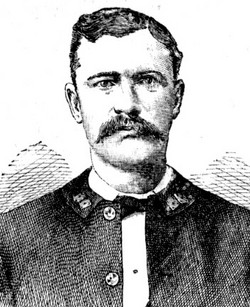 William Evans was born in Armagh in 1851. He joined the army in St. Louis, Missouri in April 1875. His Medal of Honor was awarded for carrying dispatches to Gen Crook over a distance of 100 miles through Indian territory. Evans died in St. Louis on 27th August 1881 aged 30 and is buried in Bellefontaine Cemetery in the city. |
|
|
|
Post by groundhog on Jul 29, 2013 13:50:19 GMT
[/img][/center] Robert Anderson was born in Ireland on 25th December 1843. He served as a Quartermaster in the US Navy during the Civil War aboard the USS Crusader and the USS Keokuk. He was awarded the Medal of Honor on 10th July 1863 for his service in various actions aboard both vessels. His citation mentions one action in particular at the attack on Charleston on 7th April 1863, Anderson was at the wheel of the Keokuk when Confederate cannon fire hit the wheelhouse. He used his own body to shield the Captain of the ship from shrapnel. Anderson died on 20th June 1900 and is buried in Calvary Cemetery, Portsmouth, New Hampshire.
|
|
|
|
Post by groundhog on Jul 29, 2013 16:03:09 GMT
Witchita River, Texas
12th July 1870 The battle of the Little Wichita River was fought as a result of a raid by a war party of Kiowa into Northern Texas. The Kiowa were settled on a reservation in what is now Oklahoma. Reservation life didn’t suit the nomadic, warrior lifestyle of the Kiowa and raids were frequent. Successful raiders were feted as heroes and those who talked of peace were sneered at. One such was Kicking Bird who, in order to restore his reputation, led about 100 warriors into Texas in late June of 1870 crossing the Red River into Wichita County. On July 5th a small group of warriors attacked and robbed a mail stage at Rock Station, near the site of present-day Jermyn in Jack County. Word of the attack reached Fort Richardson on the morning of July 6th and. Captain Curwen McLellan, commanding the Sixth Cavalry, led a force of 57 soldiers, a surgeon, and a civilian scout to track down the Kiowa. The site of the ambush was about 90 minutes from the fort and from there McLellan's force pursued the Indians northwest for five days, locating the Kiowa camp on the evening of 11th July. The following morning McLellan attacked the Indian camp. Within a short space of time he realized that he was outnumbered by more than two to one. Kicking Bird led a charge on the cavalrymen and personally killed a Cpl John Given with a lance. The afternoon of July 12th saw McLellan's men attacked from all sides as they desperately to retreated. Two more soldiers died during several hours of battle, their bodies havng to be abandoned on the field. Early in the evening, the Kiowa broke off their pursuit and the cavalrymen escaped across the west fork of the Trinity River. Exhausted and with eleven wounded and three killed, McLellan and his troops made camp ten miles northwest of Flat Top Mountain at midnight where they were reinforced by twenty cavalrymen and a group of cowboys from a nearby ranch. On the morning of the 13th McLellan sent to Fort Richardson for ambulances and prepared to make his final retreat. Fearing another attack, he ordered all excess baggage burned and moved his unit to a more secure location. The ambulances arrived later that day and returned to Fort Richardson on 14th. McLellan reported that the Kiowas had suffered casualties of fifteen killed and an undetermined number wounded. Kicking Bird, honour restored, returned home and led no more war parties into Texas. Two Irishmen survived the day and earned Medals of Honor for Gallantry in action which were issued on 25th August 1870. John Connor  John Connor- Corporal, Company H, 6th Cavalry was born in Galway on 1st January 1845. He joined the army in Jefferson, Texas in July 1869 and was discharged in July 1874. The following January he rejoined the 2nd Artillery and served until 1890. He died on 5th February 1907 and is buried in the United States Soldiers' and Airmen's Home National Cemetery, Washington DC. Thomas Kerrigan Kerrigan was born in Co. Tipperary in 1845. He was a Sergeant in Company H, 6th Cavalry at the Battle of Wichita River. His place and date of death are unknown but his home of record in the army was New York. |
|
|
|
Post by groundhog on Jul 30, 2013 16:17:04 GMT
Whetstone Mountains, Arizona
13th July 1872 On 13th July 1872 a cavalry detachment numbering eight men under the command of Second Lieutenant William Hall was sent from Camp Crittenden to stop an Apache raiding party which had stolen cattle from a local rancher. They pursued the Apaches into a canyon in the Whetstone Mountains, thinking that there were a small number of Indians . However there were about 80 Apaches in the raiding party and instead of the hoped-for surprise attack, the cavalrymen found themselves charged by large numbers of Apache warriors. After a brief fight, the outnumbered troopers were forced to retreat, during which a number of them became separated. Three of the eight men, two of them Irish received the Medal of Honor for bravery on the day. Michael Glynn Michael Glynn was born in Co. Galway in 1845. At the battle in the canyon, Glynn remained behind with Lt Hall and First Sgt Newman to cover the withdrawal of the wounded. Glynn was credited with single-handedly fighting off eight Apaches, five of whom he killed, and it was for this action that he received the Medal of Honor on 4th December 1874. During the fighting Glynn’s horse was killed and he himself wounded. He was found by fellow Irishman John Nihill who put the wounded man on his own horse while he held off the Apaches. Glynn’s place and date of death are unknown. John Nihill  John Nihill was born in Nenagh on 25th May 1850 and joined the US Army in New York on 10th November 1868. During the fighting on 13th July 1872, Nihill became separated from his patrol which began to retreat. Fighting his way back to his comrades, Nihill fought and killed four Apache warriors for which he was awarded the Medal of Honor. However he also gave up his mount to a comrade, Michael Glynn, with the instruction to ride to a rendezvous point in a wood three miles distant. Nihill made his way on foot to the woods, fighting off Apaches on the way. There he found Glynn, weak from his wounds and unable to mount his horse. The two men made their way back to Fort Crittenden. Perhaps on the way they may have discussed how two Shannon-siders ended up fighting Apaches in Arizona. John Nihill remained in the army for 15 years, engaging in many more battles with the Indians. He lived in New York after his retirement from the army and died on 28th May 1908. He is buried in Cypress Hills National Cemetery, Brooklyn. |
|